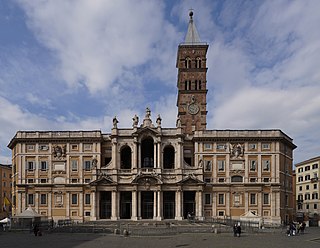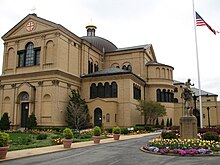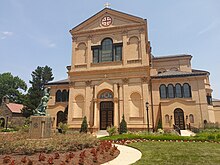
The Church of the Holy Sepulchre is a church in the Christian Quarter of the Old City of Jerusalem.

A shrine to the Virgin Mary is a shrine marking an apparition or other miracle ascribed to the Blessed Virgin Mary, or a site on which is centered a historically strong Marian devotion. Such locales are often the destinations of pilgrimages.

Brookland–CUA station is a Washington Metro station in Washington, D.C., on the Red Line. Service began on February 3, 1978. The station serves the Brookland neighborhood and the Catholic University of America (CUA). It is the focal point of an upcoming transit-oriented development project.

Northeast is the northeastern quadrant of Washington, D.C., the capital of the United States. It encompasses the area located north of East Capitol Street and east of North Capitol Street.

Brookland, also known as Little Rome or Little Vatican, is a neighborhood located in the Northeast (NE) quadrant of Washington, D.C. It is best known for its numerous Catholic institutions, including schools, religious communities, shrines, institutes, and other organizations built and based around the Catholic University of America.

The Via Dolorosa is a processional route in the Old City of Jerusalem. It represents the path that Jesus would have taken, forced by the Roman soldiers, on the way to his crucifixion. The winding route from the former Antonia Fortress to the Church of the Holy Sepulchre—a distance of about 600 metres —is a celebrated place of Christian pilgrimage. The current route has been established since the 18th century, replacing various earlier versions. It is today marked by fourteen Stations of the Cross, nine of which are outside, in the streets, with the remaining five stations being currently inside the Church of the Holy Sepulchre.
Virgilio Canio Corbo was an Italian Franciscan Friar and professor of archaeology at the Studium Biblicum Franciscanum in Jerusalem.

Bartolo Longo was an Italian lawyer who has been beatified by the Catholic Church. He was a former Satanic priest who returned to the Catholic faith and became a third order Dominican, dedicating his life to the Rosary and the Virgin Mary. He was eventually awarded a papal knighthood of the Equestrian Order of the Holy Sepulchre of Jerusalem.

The Catholic Church in Israel is part of the worldwide Catholic Church, in full communion with the Holy See in Rome. The Catholic Church in Israel is divided into three main jurisdictions: the Latin Patriarchate of Jerusalem, the Franciscan Custody of the Holy Land, and the Salesian Mission. Each of these jurisdictions has its own responsibilities and areas of operation.

Portiuncula, also spelled Porziuncola or Porzioncula, is a small Catholic church located within the Papal Basilica of Saint Mary of the Angels in Assisi in the frazione of Santa Maria degli Angeli, situated about 4 kilometres (2.5 mi) from Assisi, Umbria. It is the place from where the Franciscan movement started.

The conversion of non-Islamic places of worship into mosques occurred during the life of Muhammad and continued during subsequent Islamic conquests and under historical Muslim rule. Hindu temples, Jain Temples, Christian churches, synagogues, and Zoroastrian fire temples have been converted into mosques.

Sant'Onofrio al Gianicolo is a titular church in Trastevere, Rome. It is the official church of the papal order of knighthood Order of the Holy Sepulchre. A side chapel is dedicated to the Order and a former grand master, Nicola Canali is entombed there. It is located on the Janiculum. Since 1946, the church has been under the care of the American congregation of the Franciscan Friars of the Atonement.

The Brotherhood of the Holy Sepulchre or Holy Community of the All-Holy Sepulchre is an Eastern Orthodox monastic fraternity guarding the Church of the Holy Sepulchre and other Christian holy places in the Holy Land, founded in its present form during the British Mandate in Palestine (1920-1948). Headed by the Greek Orthodox Patriarch of Jerusalem, the brotherhood also administers the Greek Orthodox Church of Jerusalem, such as metropolitans, archbishops, bishops, archimandrites, hieromonks, hierodeacons, and monks.

The Custody of the Holy Land is a custodian priory of the Order of Friars Minor in Jerusalem, founded as the Province of the Holy Land in 1217 by Saint Francis of Assisi, who had also founded the Franciscan Order in 1209. In 1342, the Franciscans were declared by two papal bulls as the official custodians of the Holy Places in the name of the Catholic Church.

The New Church of the Theotokos, or New Church of the Mother of God, was a Byzantine church erected in Jerusalem by Emperor Justinian I. Like the later Nea Ekklesia in Constantinople, it is sometimes referred to in English as "the Nea" or the "Nea Church".

Brother Cajetan J. B. Baumann was a Franciscan friar and a noted American architect. Baumann’s designs were incredibly progressive, providing modern interpretations of Gothic architecture.

Aristide Leonori was an Italian architect and engineer. He worked mostly on religious buildings in Italy, the United States, and Africa, in a variety of styles.

Deir es-Sultan, literally the Monastery of the Sultan, is a monastery located on the roof of the Chapel of Saint Helena, which is part of the Church of the Holy Sepulchre in Jerusalem's Old City. The Status Quo, a 250-year old understanding between religious communities, applies to the site.

Alberto Gori, OFM was a Latin Patriarch of Jerusalem and Custodian of the Holy Land.






















